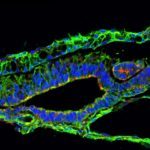Link to Pubmed [PMID] – 31974255
Science 2020 01;367(6476):453-458
Tissue morphogenesis is driven by local cellular deformations that are powered by contractile actomyosin networks. How localized forces are transmitted across tissues to shape them at a mesoscopic scale is still unclear. Analyzing gastrulation in entire avian embryos, we show that it is driven by the graded contraction of a large-scale supracellular actomyosin ring at the margin between the embryonic and extraembryonic territories. The propagation of these forces is enabled by a fluid-like response of the epithelial embryonic disk, which depends on cell division. A simple model of fluid motion entrained by a tensile ring quantitatively captures the vortex-like “polonaise” movements that accompany the formation of the primitive streak. The geometry of the early embryo thus arises from the transmission of active forces generated along its boundary.

